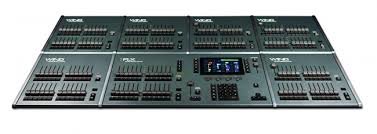-
Posts
2,573 -
Joined
-
Days Won
51
Everything posted by Jon Hole
-
Of course not, I'm just always torn between using forum names and real names whilst online!
-
Thanks kgallen 👍 tbarden - which link were you using?
-
Hi DramaKing, Have you contacted our support telephone number? Our forum isn't really the place for emergency out of hours support - especially if you have a show starting in 5 minutes! Can you describe what you mean by "hanging up" and "laggy"? Have you got "Programmer Time" enabled (press Z button, and one of the wheels will say "Programmer Time" - the middle button of the wheel will enable and disable it.
-
Hi ziglight, We're working hard to continuously improve ZerOS for all our customers. The vast majority of our Solution users are telling us they're really happy with the last few software updates. For those who aren't, they have access to the previous software. Just last week we emailed you privately to ask if you'd be interested in testing new software which specifically resolves your main concerns. Therefor I'm surprised you've taken that opportunity to publicly reopen conversations on the forum. We've covered a lot of these issues before, but I'll reply to some of the new points below. A BETA will be released soon that resolves LCD latency. I don't believe this has got worse every release - the latency started during one very specific release, in some situations, for a very specific reason (which we've talked about before - prioritising DMX data and button presses higher than LCD redrawing). We continuously use all our consoles, including Solution, for training, software testing, and personal shows & events. Please can you give examples of when the support team have "given hint might work on the FLX but does not work on Solution"? If that is the case, we'll happily go back and edit those responses as they're clearly incorrect. This was a deliberate decision based upon a lot of customer feedback - including (but not limited to) the following thread. The vast majority of our customers use Solution with an external monitor. We're able to create software that's much simpler, quicker, modern and more intuitive by depending on a monitor, rather than trying to force features onto a set of 5 x 4 buttons. To make software simpler, more intuitive, quicker and more accurate we have to make decisions like this. This is specific to Iiyama monitors - who don't provide unique identifies between their monitors which require different drivers. Therefor, we have to provide a way for you to switch driver. If it's not an Iiyama monitor, this isn't displayed. No "mystical reason" - a reason explained in detail since we launched that feature. I believe we've gone through all the other points you raise before. I'm more than happy to continue conversations on any new points that come out of this reply.
-
Sorry... the website was updated with an SSL Security Certificate yesterday (designed to make our website more secure for our customers), and the forum wasn't very happy about it! It was stopping a lot of functionality - including new signups, logging in, editing/deleting posts etc. All fixed now.
-
Hi yann, when you see the blue square, so you see text in the middle of the screen that says “Calibration not working? Press ‘Update’ and try again.” If so, have you tried doing that? Jon
-
Hi Steve, On this thread, martin-144 had success with the new Beta app. If you read through the thread, we detail how to sign up for it. Please give it a go, and let us know how you get on.
-
Hi leejlight, Do you have anything else plugged into the USB ports of Leap Frog 48? For example, a keyboard, mouse, touchscreen, usb memory stick etc? Try unplugging all USB devices (in fact, maybe unplug everything apart from power and VGA!) and see if the message continues to display.
-
Hi Martin, ZerOS Monitor acts as a wireless monitor for any ZerOS console - therefor to add this feature, we would need to add it into ZerOS, not into the app. Out of interest, do you need to see the cue list just to see which cue you're currently in, or more than that? I'm just wondering if it would be better to add the cue list intoZerOS Remote, rather than controls to ZerOS Monitor? Jon
-
Correct - if you choose to use the fader to manually crossfade, rather than the GO button and the programmed times, the GO button stops working. You can select the "Next" cue (Yellow line) using a mouse or touchscreen, and then the fader will fade to that cue
-
Hi Daneil, Probably best that you email these symtoms to Keith, our Service Manager, who can go through and diagnose where the problem is. You can email him on KeithRogers@Eaton.com or call +44(0)1633 833101
-

Solution - Solution XL VS FLX - FLX S 48
Jon Hole replied to van den abbeele Eric's topic in General Discussion
The continuation of this thread has been split into the FLX forum: -
Hi Daneil, Please can you give us some more information about what is wrong? What’s not working?
-
Look under “Get beta versions of apps” of this page: https://support.google.com/googleplay/answer/7003180?hl=en-GB
-
On Google Play there’s a Beta app available which is a complete rewrite of the backend - maybe worth giving it a try first before we investigate further?
-
Hi Martin, on Google Play you can sign up for a “beta” version of both apps - do they work? Jon
-
You can now customise your notifications from us so they're useful and relevant to you. To sign up, visit zero88.com/signup Categories include "Product Updates", "Software Updates", "Quarterly News" and/or "Competitions & Promotions". Thank you for being part of the Zero 88 Community Support Forum.
-

Solution - Solution XL VS FLX - FLX S 48
Jon Hole replied to van den abbeele Eric's topic in General Discussion
Thank you! FLX has 5 USB ports, and ZerOS Wings can be plugged directly into any of these. If you want to plug multiple ZerOS Wings into a single USB port (either to use 6 ZerOS Wings, or because you're using the USB ports for other things) these must go through a USB hub, which must be powered (ZerOS Wings are powered via USB, not via an external power supply). A USB keyboard can plug straight into the console, using the same rules as above. Currently FLX only supports QWERTY keyboards. We've had requests to add support for AZERTY, and I've added your request to our log (reference "ZOS-1955"). There are FLX training videos available here: https://www.youtube.com/playlist?list=PLXZ_FRh4YdsV_xWV1WlKzgwcTt5h5KNsA Thanks - we could definitely look at supporting you in this. Once you've got your FLX and become familiar with it we can discuss further! No problem - keep them coming! -
Hi Lex, On the Master Playback, record your base cues like normal. Then: On the cue you want the chase to start click "Settings" > "Macros" > "Trigger Cue Stacks" and select the Playback. On the cue you want the chase to finish click "Settings" > "Macros" > "Release Cue Stacks" and select the Playback The chase will fade in with the UP time of the first cue, and the chase will fade out with the DOWN time of the second cue.
-
Hi francocampo, If this happens again, please save a copy of the showfile and email it to us (even if you've already got a copy of the showfile, please save a specific version AFTER you see the problem but BEFORE you restart the console).
-

Solution - Solution XL VS FLX - FLX S 48
Jon Hole replied to van den abbeele Eric's topic in General Discussion
You can create groups that do this. You can also "Create Auto Groups" which will automatically create some groups. You'll get an "All", "Odds", "Evens", "First Half" and "Second Half" group for each type of fixture you have patched. Exactly, yes. When set to "Channels", each fader controls the intensity of the fixture assigned to the respective channel number. You can choose the Channel Number in the "Add Fixtures" screen, or change it in the "Fixture Schedule" screen - both of these are within SETUP. The Channel Number is also the number you use when controlling fixtures using syntax. So if a Moving Light is Channel 20, you could turn it on either by raising Fader 20 to the top, or by typing "20 @ 100 ENTER" (or the shortcut "20 @@") Each set of 24 faders can be set as "Channels" or "Playbacks" at any time - this doesn't affect the "Master Playback" Yes, you can add up to 6 ZerOS Wings (via a powered USB hub) giving you 168 faders. Yes - it's probably best to discuss with our French distributor who they've sold FLX to No, whatever order you wish. That's absolutely fine. FLX, as standard, has 4 Universes. That's 2048 DMX channels. There are no other limitations within that. You can also upgrade FLX up to 8 Universes (up to 4096 channels). ALL of these universes can be output on Art-Net or sACN. Two of those Universes can be output directly on DMX (that might be Universes 1 & 2, or it might be Universes 2 & 4, or it might be that you set them both to Universe 1). -
This suggests the cue on the Playback was still fading - did you have a very long fade time which made it look like the Position and Beamshape were not working, but actually they were just fading very slowly?
-
Hi Eric, No, there are currently no plans to create a button wing for FLX S, and the Enttec shortcut wings aren't currently supported. Remember you can use Palettes together with Programme Time for live control, which can reduce your dependency on Playbacks and UDKs. Jon
-
Hi Martin, The way ZerOS displays Point Cues is relatively standard across the industry. Point Cues are primarily designed as a method of adding in “extra” cues, and so usually a single decimal place is ample. Jon

